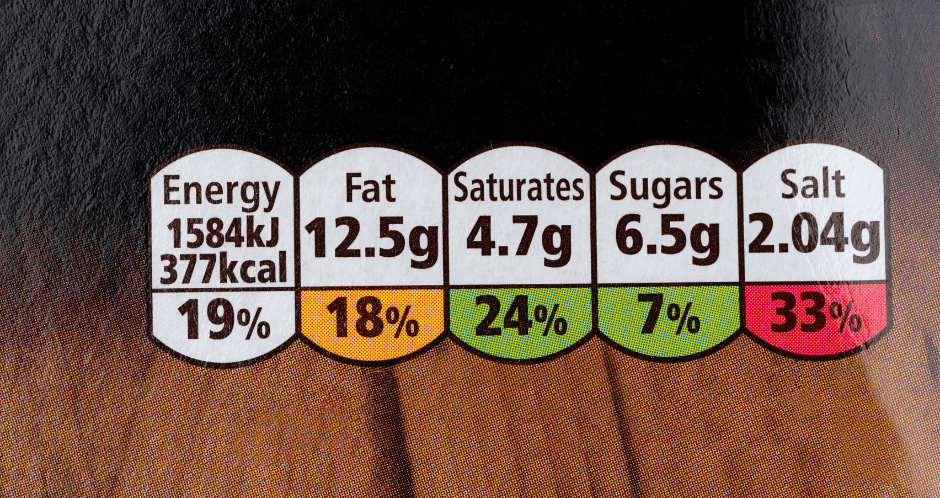Traffic Light Labelling: A Guide For Food Businesses
Traffic Light Labelling: A Guide For Food Businesses
Many food business operators choose to include colour-coded nutritional information on the front of their product packaging, to support consumers in making informed choices about the products they buy. These are known in the UK as traffic light labels, one of many forms of Front of Pack (FoP) labelling for prepackaged food and drinks used around the world.
Traffic light labelling can be helpful for consumers who want to know, at a quick glance, information about the key nutrients per portion of a product that they are consuming. However, not all food and drink operators know exactly how and when to display this information.
In this guide, we explore what the current rules are and offer guidance for businesses on the topic of traffic light labelling.
Table of Contents
What is a traffic light label?
Traffic light labels are used on the front of pre-packed food and drink products to display nutritional information in a quick and clear format. They’re intended to support consumers in making informed choices about the products they buy, using visual cues to help them consume a balanced diet.

The nutrient profiles of a product (fat, saturates, sugars, and salt) are given a red, orange, and green rating based on recommended daily intake levels.
- Red means that it is high in that nutrient, so you should be cautious about eating it too often.
- Amber means that there is a moderate amount of that nutrient, so it should be fine to eat most of the time.
- Green means that there is a low amount of that nutrient, and that it can be consumed regularly.
Percentage Reference Intake
Nutrient amounts are also displayed as a percentage reference intake (% RI) on traffic light labels. This shows, as a percentage amount, how much of an average adult’s daily intake limit of each nutrient is included in one portion.
The more greens there are and the lower the percentages, the healthier that product is likely to be. These numbers also help consumers to work out how much of that nutrient they should aim to have in other foods throughout the day.
Are FoP traffic light labels mandatory?
No. As a voluntary scheme, it’s not mandatory for products sold in the UK to use the traffic light labelling system. However, most major retailers and many major brands have opted in. When choosing to opt in, organisations agree to provide information for the amounts of: energy, fat, saturates, sugar, and salt. Approximately 2/3 of products on UK shelves display this front-of-pack labelling, and these should follow Department of Health guidelines.
Food business operators may choose to include traffic light labels on their products because it can increase consumer confidence. Customers are becoming increasingly aware of making health-conscious purchasing choices. So, at a quick glance in a supermarket or within a display, if people can see how much of each nutrient an item contains, it could influence their buying decision.
While the FoP traffic light system is voluntary, displaying essential nutritional information on the back of the pack is mandatory for most pre-packed foods.
Learn More: Nutrition Labelling: What is it & Why is it Important?
How to apply traffic light labels to your products
Should a food business operator choose to use it, there are several regulations in the retained Food Information to Consumers (FIC) regulations that must be followed to ensure food labelling compliance in the UK, these include:
- The panel must include either energy only or all the macronutrient levels (sugar, salt, fat, carbohydrates and energy). It cannot include just energy and sugar for example.
- Energy must be given as per 100g/ml and per portion (portion measurement should reflect the reality of how products are consumed)
The Department of Health, the Food Standards Agency, and devolved administrations in Scotland, Northern Ireland and Wales have developed a useful guidance document that details a step-by-step process for how to compliantly use the scheme on labelling here.
Ask yourself these questions to ensure that you are using the traffic light label compliantly:
Are we sharing all of the right information?
It’s only possible to provide information on energy OR energy AND fat, saturates, sugars and salt (sometimes referred to as ‘energy + 4’). You cannot, for example, only provide information for energy and salt.
Is the FOP labelling legible and is the font size correct?
The manner in which some of the elements of FOP labelling have to be provided is specified in GB by the retained Regulation (EU) No. 1169/2011 on the provision of food information to consumers (EU FIC). The font size needs to be equal to or greater to 1.2mm for the x-height and the information needs to be legible.
Are we using the right rounding rules for energy and for the nutrient values?
Energy values need to be declared to the nearest 1 KJ/kcal (no decimals), while the way the nutrients need to be rounded, depends on the amount – see Annex 4 in the UK government guidance for details.
Have we determined the colour coding for each nutrient correctly?
There are different cut offs for foods and drinks. There are also different cut offs for red for food products sold in portion sizes greater than 100g and drinks served in portion sizes over 150 ml – see Annex 3 in the UK government guidance for details.
What are the challenges with traffic light labels?
Traffic light labels can be helpful for people to quickly gather information about what they choose to buy and consume. But it presents challenges too. The main one being that it is not 100% fool proof; following a balanced diet usually requires more context than a quick colour-coded system can provide.
While trying to maintain simplicity, the colour coding can poorly reflect the bigger-picture nutrient content of some products.
For example, fruit juice may have a similar colour code as sugary soft drinks because of the sugars content. However, fruit juice would be a better choice of the two, as fruit juice will also provide vitamin C and fibre. Nuts are another example where the fat content may be high, but these fats are an important part of a balanced diet.
Additionally, its important to consider that they exist to help consumers decide between different brands or products in the same category – E.g “Which pizza should I eat?” Rather than comparing two unrelated products.
Further, reference intakes (RIs) are a percentage of the ‘average’ adults recommended daily intake, who do an ‘average’ amount of physical activity each day. RIs aren’t a target for every adult to hit each day. So, this information should be used as a guideline or benchmark by consumers, and not as an absolute reference, particularly on packaging on food whose usual consumer is likely to be children.
Support with FoP Traffic Light Labelling Compliance
While not mandatory, there are guidelines that businesses are required to follow if they do choose to use the traffic light labelling system on the front-of-pack. Ashbury are experts in food labelling compliance and we help food and drink businesses to launch products with complete confidence.
If you’d like to speak to an expert about the use of traffic light labels on your products, please get in touch with our team today.
Next reads
What’s Next for Food & Drink? Our Experts’ Predictions for 2026
The Peanut Diaries: School and Social Occasions
The Peanut Diaries: Navigating Social Events and Celebrations with Food Allergies
The Peanut Diaries: A Parent’s Journey to Uncovering their Child’s Allergy
Keep up to date with our latest insights
Subscribe to our mailing list to stay in touch with the latest news, insights and updates from Ashbury





